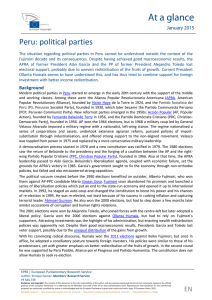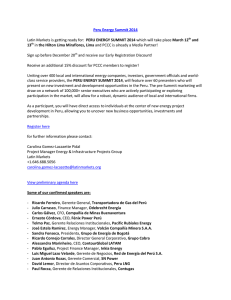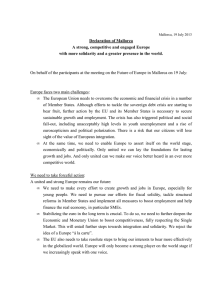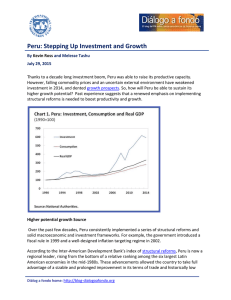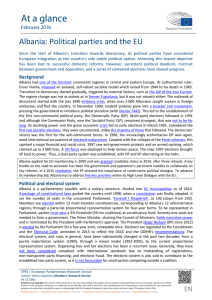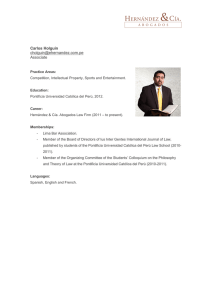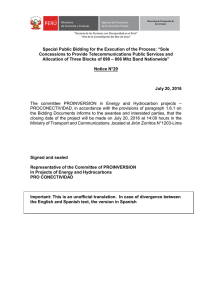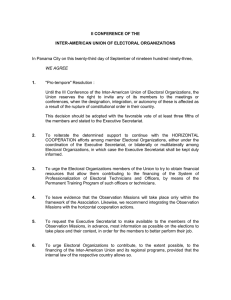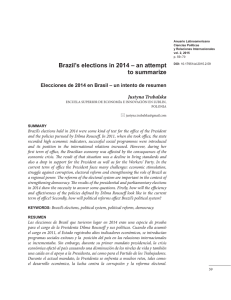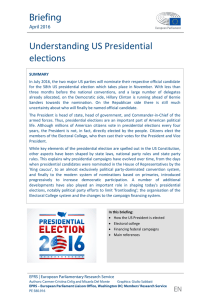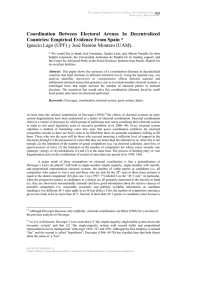Briefing European Parliamentary Research Service
Anuncio
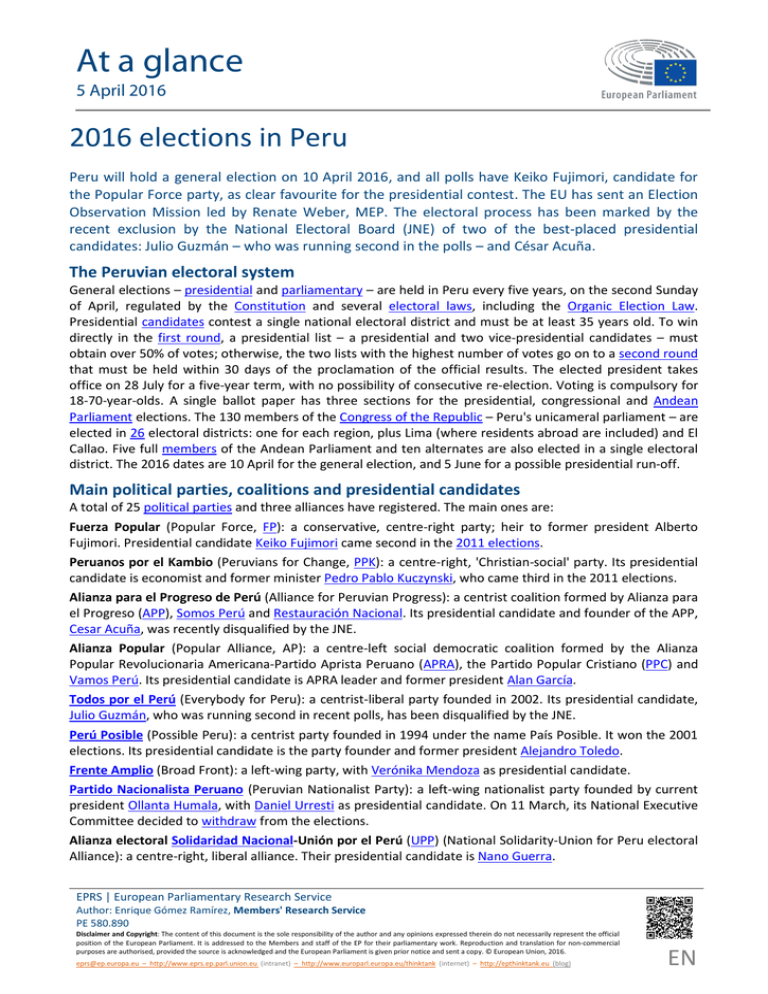
At a glance 5 April 2016 2016 elections in Peru Peru will hold a general election on 10 April 2016, and all polls have Keiko Fujimori, candidate for the Popular Force party, as clear favourite for the presidential contest. The EU has sent an Election Observation Mission led by Renate Weber, MEP. The electoral process has been marked by the recent exclusion by the National Electoral Board (JNE) of two of the best-placed presidential candidates: Julio Guzmán – who was running second in the polls – and César Acuña. The Peruvian electoral system General elections – presidential and parliamentary – are held in Peru every five years, on the second Sunday of April, regulated by the Constitution and several electoral laws, including the Organic Election Law. Presidential candidates contest a single national electoral district and must be at least 35 years old. To win directly in the first round, a presidential list – a presidential and two vice-presidential candidates – must obtain over 50% of votes; otherwise, the two lists with the highest number of votes go on to a second round that must be held within 30 days of the proclamation of the official results. The elected president takes office on 28 July for a five-year term, with no possibility of consecutive re-election. Voting is compulsory for 18-70-year-olds. A single ballot paper has three sections for the presidential, congressional and Andean Parliament elections. The 130 members of the Congress of the Republic – Peru's unicameral parliament – are elected in 26 electoral districts: one for each region, plus Lima (where residents abroad are included) and El Callao. Five full members of the Andean Parliament and ten alternates are also elected in a single electoral district. The 2016 dates are 10 April for the general election, and 5 June for a possible presidential run-off. Main political parties, coalitions and presidential candidates A total of 25 political parties and three alliances have registered. The main ones are: Fuerza Popular (Popular Force, FP): a conservative, centre-right party; heir to former president Alberto Fujimori. Presidential candidate Keiko Fujimori came second in the 2011 elections. Peruanos por el Kambio (Peruvians for Change, PPK): a centre-right, 'Christian-social' party. Its presidential candidate is economist and former minister Pedro Pablo Kuczynski, who came third in the 2011 elections. Alianza para el Progreso de Perú (Alliance for Peruvian Progress): a centrist coalition formed by Alianza para el Progreso (APP), Somos Perú and Restauración Nacional. Its presidential candidate and founder of the APP, Cesar Acuña, was recently disqualified by the JNE. Alianza Popular (Popular Alliance, AP): a centre-left social democratic coalition formed by the Alianza Popular Revolucionaria Americana-Partido Aprista Peruano (APRA), the Partido Popular Cristiano (PPC) and Vamos Perú. Its presidential candidate is APRA leader and former president Alan García. Todos por el Perú (Everybody for Peru): a centrist-liberal party founded in 2002. Its presidential candidate, Julio Guzmán, who was running second in recent polls, has been disqualified by the JNE. Perú Posible (Possible Peru): a centrist party founded in 1994 under the name País Posible. It won the 2001 elections. Its presidential candidate is the party founder and former president Alejandro Toledo. Frente Amplio (Broad Front): a left-wing party, with Verónika Mendoza as presidential candidate. Partido Nacionalista Peruano (Peruvian Nationalist Party): a left-wing nationalist party founded by current president Ollanta Humala, with Daniel Urresti as presidential candidate. On 11 March, its National Executive Committee decided to withdraw from the elections. Alianza electoral Solidaridad Nacional-Unión por el Perú (UPP) (National Solidarity-Union for Peru electoral Alliance): a centre-right, liberal alliance. Their presidential candidate is Nano Guerra. EPRS | European Parliamentary Research Service Author: Enrique Gómez Ramírez, Members' Research Service PE 580.890 Disclaimer and Copyright: The content of this document is the sole responsibility of the author and any opinions expressed therein do not necessarily represent the official position of the European Parliament. It is addressed to the Members and staff of the EP for their parliamentary work. Reproduction and translation for non-commercial purposes are authorised, provided the source is acknowledged and the European Parliament is given prior notice and sent a copy. © European Union, 2016. eprs@ep.europa.eu – http://www.eprs.ep.parl.union.eu (intranet) – http://www.europarl.europa.eu/thinktank (internet) – http://epthinktank.eu (blog) EN EPRS 2016 elections in Peru The other parties and candidates are: Vladimir Cerrón of Perú Libertario; Alfredo Barnechea of Acción Popular; Antero Flores Aráoz of Partido Político Orden; Miguel Hilario of Progresando Perú; Yehude Simón of Partido Humanista Peruano; Francisco Díez Canseco of Perú Nación; Gregorio Santos of Democracia Directa; and Fernando Olivera of Frente Esperanza. Siempre Unidos, with Felipe Castillo, and Perú Patria Segura, with Renzo Reggiardo, also recently decided to withdraw. Outlook Most opinion polls (going back to early 2013) have put Popular Force candidate Keiko Fujimori in the lead. Recent polls, from the end of March and beginning of April, maintain that forecast: Polling company DATUM GFK Vox Populi CIT IDICE IPSOS Keiko Fujimori Fuerza Popular 36.1% 37.1% 31.2% 31.2% 28.3% 34.4% Verónika Mendoza Frente Amplio 14.8% 15% 10.3% 17% 12.1% 15.5% Pedro Pablo Kuczynski Peruanos Por El Kambio 16% 15.1% 14.1% 15.9% 15.7% 16.8% Alán García Alianza Popular 3.4% 5.9% 5.6% 8.7% 15.9% 5.3% Alfredo Barnechea Acción Popular 9.3% 10.1% 12.9% 7.4% 12.7% 8% Alejandro Toledo Peru Posible 0.9% 0.8% Main candidates 1.8% Sources: Recent polls and voting simulations (March/April 2016), from Elecciones en Perú website (Encuestas Presidenciales) and Oxford Analytica. On 9 March 2016, the National Electoral Board (Jurado Nacional de Elecciones – JNE) invalidated the candidacies of Julio Guzmán and César Acuña, due to infringements in the pre-election process, and rejected their appeals on 14 March. Though Guzmán has described the decision as unprecedented, EU and OAS election observers have urged participants to respect the JNE decision. This ban may favour Fujimori – until then Guzmán was running second in the latest polls – as well as Kuczynski. A second round still appears likely. The latest IPSOS poll also points to a fragmented Congress, as no party is expected to attain more than 18% support in the parliamentary elections. Election observation In December 2015 the JNE asked Peru's External Relations Ministry to invite the OAS, the EU, the Association of World Election Bodies (AWEB), Unasur, the Inter-American Union of Electoral Bodies (Uniore), the Centro de Asesoría y Promoción Electoral (CAPEL) and the Carter Center to observe the 2016 general elections. An EU exploratory mission visited Peru from 19 to 24 January 2016, and an EU election observation mission (EU EOM) arrived on 6 March with a core team of ten election experts; they were joined on 11 March by 50 long-term observers, who will be deployed to each electoral district in two-person teams, covering the whole of the country and observing all stages of the electoral process. Renate Weber, MEP is chief observer. The mission will be supported on election day by a European Parliament delegation led by Luis de Grandes, MEP and EU diplomats posted in Peru. The 2011 elections were also observed by an EU EOM, led by José Ignacio Salafranca SánchezNeyra, MEP; the European Parliament also sent a delegation, chaired by Izaskun Bilbao Barandica, MEP. Prior to that, the EU sent an EOM to observe the 2001 elections, led by Swedish Parliament vice-president Eva Zetterberg. Peru and the EU The focus of EU-Peruvian relations is political dialogue and trade and development cooperation. They are based on the 1996 Declaration of Rome on EU relations with the Andean Community, as well as the 2009 Memorandum of Understanding with the Republic of Peru, which establishes a bilateral consultation mechanism, and is implemented through annual, high-level political meetings complemented by sectoral dialogue meetings at expert level. The latest high-level political dialogue was held in Brussels in November 2015. Peru participates actively in all EU-Latin America regional and thematic programmes, and benefits from the Partnership Instrument to support EU and Peruvian priorities in various fields. President Ollanta Humala first visited the EU institutions and addressed the European Parliament in 2012; he also attended the 2015 EU-CELAC Summit in Brussels. His most recent official visit to the EU was on 14 March 2016 to sign an extension to the short-stay Schengen visa waiver agreement between the EU and Peru – provisionally applied since 15 March, and for which the EP still has to give its consent. On that trip Humala visited the European Parliament, where he met Vice-President Antonio Tajani, EP EuroLat Delegation co-president Ramón Jaúregui, and DAND Delegation president Luis de Grandes. Members' Research Service Page 2 of 2
